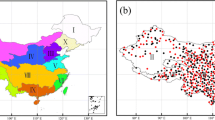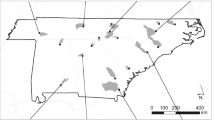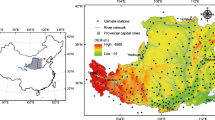Abstract
In recent decades, the climate in North and Northeast Brazil has undergone significant changes, which indicate potential risks for water and food security due to increasing temperatures, changing precipitation patterns, and greater frequency of some extreme events. For example, there is evidence of changes in the strength of the hydrological cycles on North and Northeast Brazil river basins, but the magnitude and extension of the precipitation changes are highly dependent on the precipitation dataset under consideration and the methodology. Here, we analyze the precipitation trends in North and Northeast Brazil hydrological basins and the possible associated mechanisms and present the rainfall climatological cycles in these basins using multi-datasets. The results showed that, in most river basins, there is a clear distinction between the rainy and dry seasons, with a contrast between the basins of the North (which receive a higher amount of rainfall) and the Northeast Brazil (with low rainfall volume, especially in the Parnaíba and Eastern Northeast Atlantic basins). Moreover, the annual rainfall has undergone an increasing trend in western Brazil river basins and a decreasing trend in the eastern. This east–west dipole is associated with the strengthening (weakening) of the Walker and Hadley circulations in western (eastern) Brazil in recent decades. A multidecadal variability is seen to modulate the precipitation changes, which is in phase with the AMO cycle. CMIP6 detection and attribution experiments showed that both natural and anthropogenic factors can play a role in the recent changes observed in northern Brazil river basins.











Similar content being viewed by others
Availability of data and material
All the data used in this study are available in public online databases.
Code availability
(Not applicable).
References
Adler RF, Huffman GJ, Chang A et al (2003) The version-2 global precipitation climatology project (GPCP) monthly precipitation analysis (1979-present). J Hydrometeorol 4:1146–1167. https://doi.org/10.1175/1525-7541(2003)004%3c1147:TVGPCP%3e2.0.CO;2
ANA (2015) Conjuntura dos recursos hídricos no Brasil: regiões hidrográfi cas brasileiras – Edição Especial. -- Brasília: ANA, 2015. Brasília ANA, 2015
Andrews MB, Ridley JK, Wood RA et al (2020) Historical simulations with HadGEM3-GC3.1 for CMIP6. J Adv Model Earth Syst 12:e2019MS001995. https://doi.org/10.1029/2019MS001995
Avila-Diaz A, Benezoli V, Justino F et al (2020) Assessing current and future trends of climate extremes across Brazil based on reanalyses and earth system model projections. Clim Dyn 55:1403–1426. https://doi.org/10.1007/s00382-020-05333-z
Barichivich J, Gloor E, Peylin P et al (2018) Recent intensification of Amazon flooding extremes driven by strengthened Walker circulation. Sci Adv 4:eaat8785. https://doi.org/10.1126/sciadv.aat8785
Bezerra BG, Silva LL, Santos e Silva CM, de Carvalho GG (2019) Changes of precipitation extremes indices in São Francisco River Basin, Brazil from 1947 to 2012. Theor Appl Climatol 135:565–576. https://doi.org/10.1007/s00704-018-2396-6
Bosilovich MG, Chen J, Robertson FR, Adler RF (2008) Evaluation of global precipitation in reanalyses. J Appl Meteorol Climatol 47:2279–2299. https://doi.org/10.1175/2008JAMC1921.1
Boucher O, Servonnat J, Albright AL et al (2020) Presentation and evaluation of the IPSL-CM6A-LR Climate Model. J Adv Model Earth Syst 12:e2019MS002010. https://doi.org/10.1029/2019MS002010
Cavalcanti IFA, Ferreira NJ, Dias MAF, Justi da Silva MGA (2009) Tempo e clima no Brasil. Oficina de Textos, São Paulo
Chen M, Xie P, Janowiak JE (2002) Global land precipitation: a 50-yr monthly analysis based on gauge observations. J Hydrometeorol 3:249–266. https://doi.org/10.1175/1525-7541(2002)003%3c0249:GLPAYM%3e2.0.CO;2
Dunne JP, Horowitz LW, Adcroft AJ et al (2020) The GFDL Earth System Model Version 4.1 (GFDL-ESM 4.1): overall coupled model description and simulation characteristics. J Adv Model Earth Syst 12:e2019MS002015. https://doi.org/10.1029/2019MS002015
Espinoza JC, Ronchail J, Marengo JA, Segura H (2019) Contrasting North-South changes in Amazon wet-day and dry-day frequency and related atmospheric features (1981–2017). Clim Dyn 52:5413–5430. https://doi.org/10.1007/s00382-018-4462-2
Funk C, Peterson P, Landsfeld M et al (2015) The climate hazards infrared precipitation with stations - a new environmental record for monitoring extremes. Sci Data 2:1–21. https://doi.org/10.1038/sdata.2015.66
Gloor M, Brienen RJW, Galbraith D et al (2013) Intensification of the Amazon hydrological cycle over the last two decades. Geophys Res Lett 40:1729–1733. https://doi.org/10.1002/grl.50377
Haghtalab N, Moore N, Heerspink BP, Hyndman DW (2020) Evaluating spatial patterns in precipitation trends across the Amazon basin driven by land cover and global scale forcings. Theor Appl Climatol 140:411–427. https://doi.org/10.1007/s00704-019-03085-3
IPCC (2019) Climate change and land: an IPCC special report
Jones C, Carvalho LMV (2018) The influence of the Atlantic multidecadal oscillation on the eastern Andes low-level jet and precipitation in South America. NJP Clim Atmos Sci 1:1–7. https://doi.org/10.1038/s41612-018-0050-8
Kanamitsu M, Ebisuzaki W, Woollen J et al (2002) NCEP-DOE AMIP-II reanalysis (R-2). Bull Am Meteorol Soc 83:1631–1644. https://doi.org/10.1175/bams-83-11-1631
Karoly DJ (1989) Southern hemisphere circulation features associated with El Niño-Southern Oscillation events. J Clim 2:1239–1252. https://doi.org/10.1175/1520-0442(1989)002%3c1239:shcfaw%3e2.0.co;2
Kayano MT, Capistrano VB, Andreoli RV, de Souza RAF (2016) A further analysis of the tropical Atlantic SST modes and their relations to north-eastern Brazil rainfall during different phases of Atlantic Multidecadal Oscillation. Int J Climatol 36:4006–4018. https://doi.org/10.1002/joc.4610
Kayano MT, Andreoli RV, Garcia SR, de Souza RAF (2018) How the two nodes of the tropical Atlantic sea surface temperature dipole relate the climate of the surrounding regions during austral autumn. Int J Climatol 38:3927–3941. https://doi.org/10.1002/joc.5545
Kayano MT, Andreoli RV, de Souza RAF (2020) Pacific and Atlantic multidecadal variability relations to the El Niño events and their effects on the South American rainfall. Int J Climatol 40:2183–2200. https://doi.org/10.1002/joc.6326
Kelley M, Schmidt GA, Nazarenko LS et al (2020) GISS-E21: Configurations and climatology. J Adv Model Earth Syst 12:e2019MS002025. https://doi.org/10.1029/2019MS002025
Kodama Y (1992) Large-scale common features of subtropical precipitation zones ( the Baiu Frontal Zone, the SPCZ, and the SACZ ) part I: characteristics of subtropical frontal zones. J Meteorol Soc Japan 70:813–836
Kodama YM (1993) Large-scale common features of sub-tropical convergence zones (The Baiu frontal zone, the SPCZ, and the SACZ) part II: conditions of the circulations for generating the STCZs. J Meteorol Soc Japan 71:581–610. https://doi.org/10.2151/jmsj1965.71.5_581
Kousky VE (1979) Frontal influences on northeast Brazil. Mon Weather Rev 107:1140–1153. https://doi.org/10.1175/1520-0493(1979)107%3c1140:FIONB%3e2.0.CO;2
Kousky VE, Kagano MT, Cavalcanti IFA (1984) A review of the Southern Oscillation: oceanic-atmospheric circulation changes and related rainfall anomalies. Tellus A 36A:490–504. https://doi.org/10.1111/j.1600-0870.1984.tb00264.x
Liang YC, Lo MH, Lan CW et al (2020) Amplified seasonal cycle in hydroclimate over the Amazon river basin and its plume region. Nat Commun 11:1–11. https://doi.org/10.1038/s41467-020-18187-0
Luiz Silva W, Xavier LNR, Maceira MEP, Rotunno OC (2019) Climatological and hydrological patterns and verified trends in precipitation and streamflow in the basins of Brazilian hydroelectric plants. Theor Appl Climatol 137:353–371. https://doi.org/10.1007/s00704-018-2600-8
Marcuzzo FFN (2017) Bacias Hidrográficas E Regiões Hidrográficas Do Brasil: Cálculo De Áreas, Diferenças E Considerações Hydrographic Watersheds and Hydrographic Regions in Brazil: Area Calculation, Differences and Considerations. ABRH - XXII Simp Bras Recur Hidricos
Marengo JA (1992) Interannual variability of surface climate in the Amazon basin. Int J Climatol 12:853–863. https://doi.org/10.1002/joc.3370120808
Marengo JA, Alves LM, Soares WR et al (2013) Two contrasting severe seasonal extremes in tropical South America in 2012:flood in Amazonia and drought in Northeast Brazil. J Clim 26:9137–9154. https://doi.org/10.1175/JCLI-D-12-00642.1
McGregor S, Timmermann A, Stuecker MF et al (2014) Recent walker circulation strengthening and pacific cooling amplified by atlantic warming. Nat Clim Chang 4:888–892. https://doi.org/10.1038/nclimate2330
Mondal A, Kundu S, Mukhopadhyay A (2012) case study 70 rainfall trend analysis by Mann-Kendall Test: a case study of north-eastern part of Cuttack District, Orissa
Pettitt AN (1979) A non-parametric approach to the change-point problem. Appl Stat 28:126. https://doi.org/10.2307/2346729
Philander SGH (1986) Unusual conditions in the tropical Atlantic Ocean in 1984. Nature 322:236–238. https://doi.org/10.1038/322236a0
Ropelewski CF, Halpert MS (1987) Global and regional scale precipitation patterns associated with the El Niño/Southern Oscillation. Mon Weather Rev 115:1606–1626. https://doi.org/10.1175/1520-0493(1987)115%3c1606:garspp%3e2.0.co;2
Schneider U, Becker A, Finger P, et al (2015) GPCC Full Data Reanalysis Version 7.0 at 0.5°: monthly land-surface precipitation from rain-gauges built on GTS-based and historic data
Seland Ø, Bentsen M, Olivié D et al (2020) Overview of the Norwegian Earth System Model (NorESM2) and key climate response of CMIP6 DECK, historical, and scenario simulations. Geosci Model Dev 13:6165–6200. https://doi.org/10.5194/gmd-13-6165-2020
Shiklomanov IAPHG (1993) World fresh water resources, water in crisis. A guide to the world’s water resources. Oxford Univ Press, Oxford
Shimizu MH, Ambrizzi T (2016) MJO influence on ENSO effects in precipitation and temperature over South America. Theor Appl Climatol 124:291–301. https://doi.org/10.1007/s00704-015-1421-2
Shimizu MH, Ambrizzi T, Liebmann B (2017) Extreme precipitation events and their relationship with ENSO and MJO phases over northern South America. Int J Climatol 37:2977–2989. https://doi.org/10.1002/joc.4893
Shimizu MH, Sampaio G, Venancio IM, Maksic J (2020) Seasonal changes of the South American monsoon system during the Mid-Holocene in the CMIP5 simulations. Clim Dyn 54:2697–2712. https://doi.org/10.1007/s00382-020-05137-1
Swart NC, Cole JNS, Kharin VV et al (2019) The Canadian Earth System Model version 5 (CanESM5.0.3). Geosci Model Dev 12:4823–4873. https://doi.org/10.5194/gmd-12-4823-2019
Tatebe H, Ogura T, Nitta T et al (2019) Description and basic evaluation of simulated mean state, internal variability, and climate sensitivity in MIROC6. Geosci Model Dev 12:2727–2765. https://doi.org/10.5194/gmd-12-2727-2019
Voldoire A, Saint-Martin D, Sénési S et al (2019) Evaluation of CMIP6 DECK experiments with CNRM-CM6-1. J Adv Model Earth Syst 11:2177–2213. https://doi.org/10.1029/2019MS001683
Wang XY, Li X, Zhu J, Tanajura CAS (2018) The strengthening of Amazonian precipitation during the wet season driven by tropical sea surface temperature forcing. Environ Res Lett 13:094015. https://doi.org/10.1088/1748-9326/aadbb9
Xie P, Arkin PA (1997) Global precipitation: a 17-year monthly analysis based on gauge observations, satellite estimates, and numerical model outputs. Bull Am Meteorol Soc 78:2539–2558. https://doi.org/10.1175/1520-0477(1997)078%3c2539:GPAYMA%3e2.0.CO;2
Yoon JH, Zeng N (2010) An Atlantic influence on Amazon rainfall. Clim Dyn 34:249–264. https://doi.org/10.1007/s00382-009-0551-6
Yukimoto S, Kawai H, Koshiro T, et al (2019) The meteorological research institute Earth system model version 2.0, MRI-ESM2.0: description and basic evaluation of the physical component. J Meteorol Soc Japan 97:. https://doi.org/10.2151/jmsj.2019-051
Zhou J, Lau KM (2001) Principal modes of interannual and decadal variability of summer rainfall over South America. Int J Climatol 21:1623–1644. https://doi.org/10.1002/joc.700
Acknowledgements
The authors thank NOAA Earth System Research Laboratories (ESRL), the National Centers for Environmental Prediction (NCEP), the Climate Hazards Center (CHC), and the Program for Climate Model Diagnosis and Intercomparison (PCMDI) for providing precipitation, atmospheric circulation, and CMIP6 datasets. The authors thank the anonymous reviewer for his/her useful suggestions.
Funding
The Conselho Nacional de Desenvolvimento Científico e Tecnológico (CNPq) of Brazil supported partially the third author under grants 302322/2017–5.
Author information
Authors and Affiliations
Contributions
All the authors contributed to the study conception and design. Data analyses were performed by Marília Harumi Shimizu and Juliana Aparecida Annochi. The first draft of the manuscript was written by Marília Harumi Shimizu and all the authors commented on the previous versions of the manuscript. All the authors read and approved the final manuscript.
Corresponding author
Ethics declarations
Ethics approval.
(Not applicable).
Consent to participate.
(Not applicable).
Consent for publication.
(Not applicable).
Conflict of interest
(Not applicable).
Additional information
Publisher's note
Springer Nature remains neutral with regard to jurisdictional claims in published maps and institutional affiliations.
Rights and permissions
About this article
Cite this article
Shimizu, M.H., Anochi, J.A. & Kayano, M.T. Precipitation patterns over northern Brazil basins: climatology, trends, and associated mechanisms. Theor Appl Climatol 147, 767–783 (2022). https://doi.org/10.1007/s00704-021-03841-4
Received:
Accepted:
Published:
Issue Date:
DOI: https://doi.org/10.1007/s00704-021-03841-4




